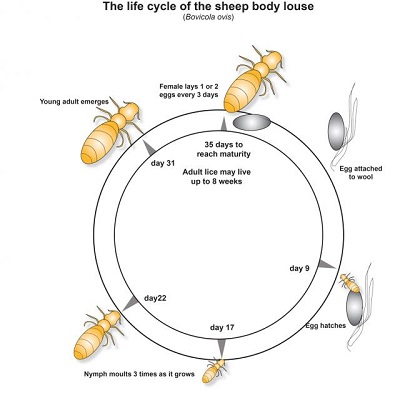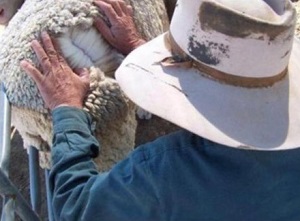What is Sheep Body Lice?
Sheep body lice (Bovicola ovis) are responsible for most lice infestations of sheep and cost Australian sheep producers millions a year.
Body lice are a common problem in Victorian sheep flocks and cause significant economic loss as a result of:
- Decreased wool quality and quantity
- Treatment costs (both chemicals and labour)
- Limited market opportunities (it is an offence to sell lousy sheep in Victorian saleyards)
The body louse is a small insect around 1-2mm in length. Young lice (nymphs) are cream coloured with a red-brown head, while adult lice have reddish-brown stripes across their body. Lice feed on dead skin of sheep, lanolin, skin bacteria and sweat gland secretions. All stages live and breed only on sheep and most will die within a week when separated from their host.

Sheep body lice lifecycle. Source: DPIRD WA
Checking For Lice
It is difficult to see lice in small numbers on sheep. The best time to see lice is immediately prior to shearing. Producers should check all mobs at least twice a year (i.e. during crutching and before shearing) and check any sheep with rubbed or pulled wool.
To check:
- Make sure to be in bright sunlight
- Make a number of parts (about 10) on each side starting at the neck and working along the side of the sheep to thigh, especially where the sheep have rubbed or where the wool is matted.
You will see the lice move away from the light. On shorn sheep, protected areas around the folds on the neck are the preferred areas. In woolly sheep, the mid-sides will generally hold the greatest numbers
Wool damage is usually only obvious once there is at least three months’ growth of wool and significant lice numbers.

Parting the wool to the skin to inspect for lice. Source: Peter James - LiceBoss
For more info on how to check and monitor for lice, see the LiceBoss website.
Treatment
Effective treatment of all sheep in the flock is necessary to fully eradicate lice. Lousy sheep that have been treated may not show signs of infestation for up to nine months after treatment. Usually this is due to the treatment not eradicating all lice.
When selecting a treatment product, consider selecting a treatment for ewes as well. Depending on the product, it can take between 2 and 18 weeks after treatment for lice to die. If lambs are born during this period, they can become infested and re-infest ewes.
The best time to treat sheep for lice is soon after shearing, using a plunge dip. This allows the best chance of eradication and also minimises residue in wool (remembering wool processors will not tolerate chemical residues).
Opportunities to eliminate lice are “off-shears” (0-24 hours after shearing) or in short wool (1-42 days after shearing). Use of long wool backliners should only be considered as a control tool to limit further wool damage before shearing, but be aware of the wool harvest intervals. If you are going to the expense of treating lice, ensure you don’t leave any sheep behind when mustering and that you treat all sheep.
Off-Shears Backline
When To Use
- Immediately after shearing <24 hours unless stated otherwise
Advantages
- Less labour intensive
Disadvantages
- Slow to kill
- High chemical cost
- Effectiveness reduced in sheep not cleanly shorn
Notes
- If used properly some can achieve eradication
Long-Wool Backline
When To Use
- 6 weeks – 10 months wool
Advantages
- Less labour intensive
- Low maintenance
- No discharge of used dipwash
Disadvantages
- Slow to kill
- High chemical cost
- Potential for high chemical residue in wool
Notes
- Apply evenly from poll to tail
Jetting
When To Use
- Used as a control method until lice can be eradicated at shearing
Notes
- Control only
Plunge Dip
When To Use
- 3 weeks off-shears
Advantages
- Very effective if used correctly
- Contractors available who have a mobile plunging system
Disadvantages
- Expensive to set up own facilities
- Labour intensive
- Bacterial infection can be spread
Shower Dip
When to use
2-3 weeks off shears
Advantages
- Less labour intensive
Disadvantages
- Generally less effective
- Expensive to set up own facilities
- Difficult to achieve necessary saturation for maximum effectiveness
- More chemical exposure for operator
- Method not regularly used
Always read the label and consider residues and withholding periods when selecting and using chemicals for control and eradication of lice. Remember, selling lousy sheep through saleyards is illegal.
Prevention
There are a number of steps that can be carried out on farm to prevent lice infestation. Carrying out best practice management and biosecurity strategies is the best way to prevent introducing lice to your flock as well as other sheep diseases.
Boundaries
Ensure boundaries are maintained and “sheep-proof”. These can include fences, timber plantations, creek crossings, etc. and will minimise strays and interaction of animals between fences. Pay particular attention to timber or tree plantations where stray sheep can remain undetected and intermingle with your sheep.
Introduce buffer zones along boundary fences. This is optional but will allow you to deal with stray sheep before they come into contact with your own sheep.
Work with your neighbours to establish a “no stray” policy. Discuss improving fences and strategies to prevent and manage lice problems in your area. Should a neighbour find one of your sheep on their property, ask them not to put it back over the fence but contact you for collection. This means you can quarantine stray animals before re-introducing them to your flock.
New Sheep
Always inspect sheep before purchasing new stock and ask for a National Sheep Health Statement.
Isolate new sheep on arrival until the next shearing to minimise the chance of introducing lice (or other diseases) to your flock. Keeping records of stock movement around the farm can be effective in managing the risk of spreading lice throughout your flock.
Shearers
Shearers can transfer (adult) lice inadvertently on their moccasins for up to 10 days after they have worked on properties with heavy lice infestations. There is a low probability of this occurring and should not be your main focus of prevention. However microwaving moccasins for 5 minutes can minimise the risk of transfer.
Best practice management and biosecurity strategies are the best way to preventing introducing lice to your stock.
Further Resources
LiceBoss is an effective online tool that can be used to help aid producers in constructing a lice control management plan specific to their region.
Meat & Livestock Australia – Lice
NSW Department of Primary Industries – Sheep Lice



